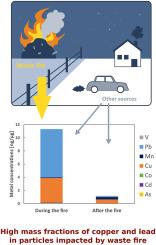瑞典斯德哥尔摩一场大型垃圾火灾中颗粒物的排放率和组成
IF 3.7
2区 环境科学与生态学
Q2 ENVIRONMENTAL SCIENCES
引用次数: 0
摘要
不受控制的废物燃烧和意外的废物火灾是向空气中排放的重要来源。然而,目前只有很少的实地研究提供这些排放的数据。在本研究中,我们调查了瑞典斯德哥尔摩县一次大型垃圾火灾的排放率、污染物扩散和颗粒组成。我们的研究结果表明,垃圾火灾在燃烧时,可能对其所在城市(约95,000名居民)道路交通平均PM10排放量的贡献高达5倍,这突出了垃圾火灾等临时事件对空气质量的潜在影响。高斯色散计算用于模拟测量PM10数据的空间分布,证明其用于评估暴露和沉积。与火灾后收集的颗粒相比,受废火影响的颗粒富含几种潜在有毒金属和类金属,包括砷、铜、镉,特别是铅。此外,与火灾后相比,由于相关多环芳烃的质量分数较大,它们在每质量基础上也可能造成更高的癌症风险。本文章由计算机程序翻译,如有差异,请以英文原文为准。

Emission rates and composition of particulate matter from a large waste fire in Stockholm, Sweden
Uncontrolled waste burning and accidental waste fires are an important source of emissions into the air. However, there are currently only few field studies providing data on these emissions. In this study, we investigated the emission rates, pollutant dispersion and particle composition for a large waste fire in Stockholm county, Sweden. Our results show that the waste fire, while burning, may have contributed as much as 5 times the mean PM10 emissions from road traffic of the municipality it was located in (ca 95 000 inhabitants), which highlights the potential impact of temporary events such as waste fires on air quality. Gaussian dispersion calculations were used to model the spatial distribution of measured PM10 data, demonstrating its use for assessment of exposure and deposition. Particles impacted by the waste fire were enriched in several potentially toxic metals and metalloids including arsenic, copper, cadmium and, in particular, lead when compared to particles collected after the fire. In addition, they may also pose an increased cancer risk on a per-mass basis compared to the post-fire period due to the larger mass fraction of relevant PAHs.
求助全文
通过发布文献求助,成功后即可免费获取论文全文。
去求助
来源期刊

Atmospheric Environment
环境科学-环境科学
CiteScore
9.40
自引率
8.00%
发文量
458
审稿时长
53 days
期刊介绍:
Atmospheric Environment has an open access mirror journal Atmospheric Environment: X, sharing the same aims and scope, editorial team, submission system and rigorous peer review.
Atmospheric Environment is the international journal for scientists in different disciplines related to atmospheric composition and its impacts. The journal publishes scientific articles with atmospheric relevance of emissions and depositions of gaseous and particulate compounds, chemical processes and physical effects in the atmosphere, as well as impacts of the changing atmospheric composition on human health, air quality, climate change, and ecosystems.
 求助内容:
求助内容: 应助结果提醒方式:
应助结果提醒方式:


